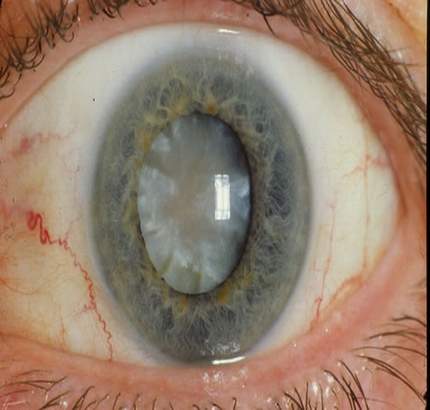
What's in this article?
Cataracts Definition
A cataract is a clouding of the normally clear lens of your eye. For people who have cataracts, seeing through cloudy lenses is a bit like looking through a frosty or fogged-up window.
Clouded vision caused by cataracts can make it more difficult to read, drive a car (especially at night) or see the expression on a friend’s face.
Most cataracts develop slowly and don’t disturb your eyesight early on. But with time, cataracts will eventually interfere with your vision.
At first, stronger lighting and eyeglasses can help you deal with cataracts. But if impaired vision interferes with your usual activities, you might need cataract surgery. Fortunately, cataract surgery is generally a safe, effective procedure.
What Causes Cataracts?
The eye functions much like a camera. Light rays enter the eye, passing through the cornea, the aqueous humor transparent fluid in the front of the eye and then the pupil and into the lens. The lens bends the light rays to focus objects onto the retina lining the back of the eye. From there, the image passes through the retinal cells, into the optic nerve, and finally to the back of the brain which process the images.
Cataracts occur when there is a buildup of protein in the lens that makes it cloudy. This prevents light from passing clearly through the lens, causing some loss of vision. Since new lens cells form on the outside of the lens, all the older cells are compacted into the center of the lens resulting in the cataract.
What are the symptoms of Cataracts?
You may not notice any symptoms with early cataracts. As a cataract becomes more advanced, decrease in clarity of vision, not fully correctable with glasses, is noticed. There is a loss of contrast sensitivity, so that shadows and color vision are less vivid. Disturbing glare may be noted as light is into the eye scattered by the cataract. Haloes may be observed around lights. Night vision will be diminished. In certain types of cataracts, double vision may be noted in the affected eye. Some patients note that they require frequent changes in their eyeglass or contact lens prescriptions and may be aware that their near vision is improving as their distance vision declines.
A cataract does not routinely cause discomfort or pain in the eye or alter the external appearance of the eye.
Diagnosis of Cataracts
Cataracts can be diagnosed through a comprehensive eye examination. This examination may include:
- Patient history to determine vision difficulties experienced by the patient that may limit their daily activities and other general health concerns affecting vision.
- Visual acuity measurement to determine to what extent a cataract may be limiting clear vision at distance and near.
- Refraction to determine the need for changes in an eyeglass or contact lens prescription.
- Evaluation of the lens under high magnification and illumination to determine the extent and location of any cataracts.
- Evaluation of the retina of the eye through a dilated pupil.
- Measurement of pressure within the eye.
- Supplemental testing for color vision and glare sensitivity.
Additional testing may be needed to determine the extent of impairment to vision caused by a cataract and to evaluate whether other eye diseases may limit vision following cataract surgery.
Using the information obtained from these tests, your optometrist can determine if you have cataracts and advise you on options for treatment.
How Are Cataracts Treated?
If your vision can be corrected to an acceptable level with a change in prescription, eyeglasses, including bifocals or contacts, may be prescribed, eliminating the need for surgery at that time.
If your vision loss cannot be corrected with new glasses and cataracts interfere with your daily life, you may be a candidate for cataract surgery, which involves removing the clouded lens and replacing it with a clear, artificial one.
Cataract surgery is usually conducted on an outpatient basis and is very successful in restoring vision. It is the most frequently performed surgery in the U.S., with more than 1.5 million cataract surgeries done each year. Far more tan 90 percent of the people who have cataract surgery have improvement in vision.
Talk to your doctor to see which treatment is right for you.





